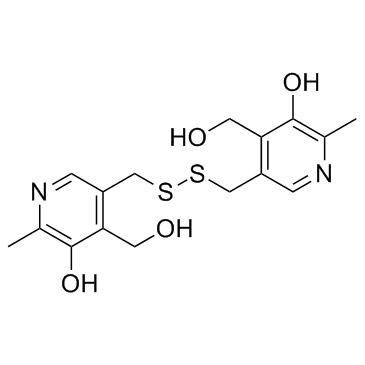Pyrithioxin

Pyrithioxin structure
|
Common Name | Pyrithioxin | ||
|---|---|---|---|---|
| CAS Number | 1098-97-1 | Molecular Weight | 368.47100 | |
| Density | 1.448 g/cm3 | Boiling Point | 742.8ºC at 760 mmHg | |
| Molecular Formula | C16H20N2O4S2 | Melting Point | 54-57 °C(lit.) | |
| MSDS | Chinese USA | Flash Point | >230 °F | |
| Symbol |


GHS05, GHS07 |
Signal Word | Danger | |
Use of PyrithioxinPyrithioxin is a neurodynamic compound, combined with a short period of hyperventilation (HV) was applied in cerebral infarct patients with Hemiplegia. |
| Name | 5-[[[5-hydroxy-4-(hydroxymethyl)-6-methylpyridin-3-yl]methyldisulfanyl]methyl]-4-(hydroxymethyl)-2-methylpyridin-3-ol |
|---|---|
| Synonym | More Synonyms |
| Description | Pyrithioxin is a neurodynamic compound, combined with a short period of hyperventilation (HV) was applied in cerebral infarct patients with Hemiplegia. |
|---|---|
| Related Catalog | |
| References |
| Density | 1.448 g/cm3 |
|---|---|
| Boiling Point | 742.8ºC at 760 mmHg |
| Melting Point | 54-57 °C(lit.) |
| Molecular Formula | C16H20N2O4S2 |
| Molecular Weight | 368.47100 |
| Flash Point | >230 °F |
| Exact Mass | 368.08600 |
| PSA | 157.30000 |
| LogP | 2.57080 |
| InChIKey | SIXLXDIJGIWWFU-UHFFFAOYSA-N |
| SMILES | Cc1ncc(CSSCc2cnc(C)c(O)c2CO)c(CO)c1O |
CHEMICAL IDENTIFICATION
HEALTH HAZARD DATAACUTE TOXICITY DATA
|
| Symbol |


GHS05, GHS07 |
|---|---|
| Signal Word | Danger |
| Hazard Statements | H315-H318-H335 |
| Precautionary Statements | P261-P280-P305 + P351 + P338 |
| Hazard Codes | Xi |
| Risk Phrases | 36/37/38 |
| Safety Phrases | 26 |
| RIDADR | NONH for all modes of transport |
| WGK Germany | 2 |
| RTECS | UT4836666 |
| HS Code | 2933399090 |
| HS Code | 2933399090 |
|---|---|
| Summary | 2933399090. other compounds containing an unfused pyridine ring (whether or not hydrogenated) in the structure. VAT:17.0%. Tax rebate rate:13.0%. . MFN tariff:6.5%. General tariff:20.0% |
|
[The use of encephabol in neurological practice].
Zh. Nevrol. Psikhiatr. Im. S. S. Korsakova 102(6) , 53-6, (2002)
|
|
|
Stability-indicating chemometric methods for the determination of pyritinol dihydrochloride.
Drug Test. Anal. 1(5) , 228-33, (2009) Three multivariate calibration methods, including classical least square with nonzero intercept (CLS), principal component regression (PCR) and partial least square (PLS), have been used for the deter... |
|
|
Pyritinol reduces nociception and oxidative stress in diabetic rats
Eur. J. Pharmacol. 590(1-3) , 170-6, (2008) The purpose of this study was to assess the antinociceptive and antiallodynic effect of pyritinol as well as its possible mechanism of action in diabetic rats. Streptozotocin (50 mg/kg) injection caus... |
| Epocan |
| Dipyridoxolyldisulfide |
| Pyrithioxine |
| MFCD00151477 |
| Bonifen |
| Piritinol |
| Pyridoxine disulfide |
| Bonol |
| PYRITINOL |
| Encefabol |
| Pyrithioxin |
| EINECS 214-150-1 |